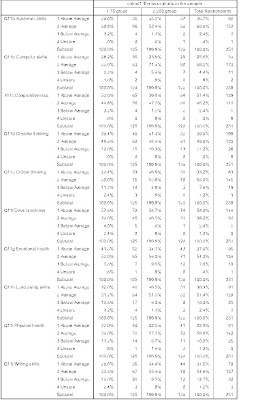Here is a very nice and succinct analysis of the difference between confirmatory vs. exploratory data analysis:
http://www.geog.ucsb.edu/~joel/g210_w07/lecture_notes/lect01/oh07_01_2.html
So, my dissertation would be more on the exploratory side.....
I will try to collect all my SPSS/STATA and other stats notes here!!
Thursday 16 December 2010
Tuesday 14 December 2010
Date & Time in SPSS
COMPUTE NewVar = YRMODA(yrVar, moVar, daVar).
to get months out of days data, divide it by 30.4375
365.25 days: the average length of a year in the Julian calendar.
to get months out of days data, divide it by 30.4375
365.25 days: the average length of a year in the Julian calendar.
Thursday 9 December 2010
Another good table made with CTable
 Here is the syntax for the above table:
Here is the syntax for the above table:CTABLES
/TABLE cohort1>( Q11a +Q11b +A11c +Q11d +Q11e +Q11f +Q11g +Q11h +Q11i +Q11j) [COUNT ROWPCT]
/SLABELS VISIBLE=NO
/CLABELS ROWLABELS=OPPOSITE
/CATEGORIES VARIABLES= cohort1 TOTAL=YES LABEL='Total'
/CATEGORIES VARIABLES= Q11a Q11b A11c Q11d Q11e Q11f Q11g Q11h Q11i Q11j TOTAL=YES LABEL='RowTotal'
/TITLE TITLE = 'Q11_: Ranking of abilities by students: (row percents) '+
'by cohort'
CAPTION= 'Report created at )TIME on )DATE' ')TABLE'.
Really nice table
 For the above, use this syntax:
For the above, use this syntax:CTABLES
/TABLE (Q11a +Q11b +A11c +Q11d +Q11e +Q11f +Q11g +Q11h +Q11i +Q11j) [COLPCT] [COUNT] BY cohort1
/SLABELS VISIBLE=NO
/CATEGORIES VARIABLES=cohort1 TOTAL=YES LABEL='Total Respondents'
/CATEGORIES VARIABLES= Q11a Q11b A11c Q11d Q11e Q11f Q11g Q11h Q11i Q11j [1, 2, 3, 4, SUBTOTAL, OTHERNM] EMPTY=INCLUDE POSITION=AFTER.
/TITLE TITLE = 'Ranking of abilities by students '+
'by cohort'
CAPTION= 'Report created at )TIME on )DATE' ')TABLE'.
Wednesday 8 December 2010
More CTable commands in Syntax
% in columns and Ns is col after it.
CTABLES /TABLE NEWS [COUNT COLPCT] /SLABELS POSITION=ROW VISIBLE=NO.
Or the same thing but the Ns in rows instead of a separate column.
CTABLES /TABLE NEWS [COUNT COLPCT].
CTABLES /TABLE (CONFINAN + CONBUS + CONBUS + CONEDUC + CONPRESS + CONMEDIC)[COUNT ROWPCT] /CLABELS ROWLABELS=OPPOSITE.
CTABLES /TABLE $MLTNEWS [COUNT COLPCT] BY SEX /SLABELS VISIBLE=NO /CATEGORIES VARIABLES=SEX TOTAL=YES.
CTABLES /TABLE POLVIEWS [COLPCT] BY AGECAT.
CTABLES /TABLE (CONFINAN + CONEDUC + CONBUS + CONMEDIC + CONPRESS + CONTV ) /SLABELS VISIBLE=NO /CLABELS ROWLABELS=OPPOSITE
OR
CTABLES /TABLE (CONFINAN + CONEDUC + CONBUS + CONMEDIC + CONPRESS + CONTV )
To add "Totals"
CTABLES /TABLE NEWS [COUNT COLPCT] /SLABELS POSITION=ROW VISIBLE=NO.
Or the same thing but the Ns in rows instead of a separate column.
CTABLES /TABLE NEWS [COUNT COLPCT].
CTABLES /TABLE (CONFINAN + CONBUS + CONBUS + CONEDUC + CONPRESS + CONMEDIC)[COUNT ROWPCT] /CLABELS ROWLABELS=OPPOSITE.
CTABLES /TABLE $MLTNEWS [COUNT COLPCT] BY SEX /SLABELS VISIBLE=NO /CATEGORIES VARIABLES=SEX TOTAL=YES.
CTABLES /TABLE POLVIEWS [COLPCT] BY AGECAT.
CTABLES /TABLE (CONFINAN + CONEDUC + CONBUS + CONMEDIC + CONPRESS + CONTV ) /SLABELS VISIBLE=NO /CLABELS ROWLABELS=OPPOSITE
OR
CTABLES /TABLE (CONFINAN + CONEDUC + CONBUS + CONMEDIC + CONPRESS + CONTV )
To add "Totals"
CTABLES /TABLE AGECAT
/CATEGORIES VARIABLES=AGECAT TOTAL=YES LABEL='Total Respondents'./TABLE SEX [COUNT] + HAPPY [COUNT, COLPCT] /TABLE (SEX + HAPPY [COLPCT])[COUNT]
Tuesday 7 December 2010
Nesting in CTABLE and sorted results
example 1:
CTABLES /TABLE SEX > HAPMAR [COLPCT] BY CHILDCAT.
example 2:
CTABLES /TABLE SEX > HAPMAR BY CHILDCAT.
OR
CTABLES /TABLE (HAPPY + HAPMAR) > SEX.
choose one of the above depending on how you want the variable SEX
to be displayed the first example brings it out as the outer most variable,
while the 2nd one puts it as the inner most.
The following will give sorted result (Descending) based on
the variable CAR1 by age group
of respondent:
CTABLES
/TABLE CAR1 BY AGECAT
/CATEGORIES VARIABLES=AGECAT TOTAL=YES
/CATEGORIES VARIABLES=CAR1 ORDER=D KEY=COUNT.
(Source SPSS help file)
*In addition to the above, I want to add column percents
and Ns to the tables!!
Tuesday 30 November 2010
Choosing the right test
From the university of Alabama.
http://bama.ua.edu/~jleeper/627/choosestat.html
http://bama.ua.edu/~jleeper/627/choosestat.html
Saturday 27 November 2010
RECODE in STATA
recode var names (1 2 = 1 low) ///
(3 = 2 medium) ///
(4 5 = 3 high) ///
(nonmissing = 9 "something else") ///
(missing = .) ///
, gen(Rx Ry) label(Cat3)
Use mvencode and mvdecode to deal with missing values.
For example to convert 99 into sysmis
in the variable mstatus,
mvdecode mstatus, mv(99)
For the opposite effect,
mvencode mstatus, mv(99)
Wednesday 24 November 2010
Computing Age from DOB in SPSS
There are million ways to do this. but here is what worked for me. You will need your date of birth variable to have month, day and year.
COMPUTE age_year = (DATE.MDY(11,01,2010) - BirthDate) / (60*60*24*365.25) .
COMPUTE age=RND(age_year).
FORMATS age (F3.0).
*fre age.
NOTE: This will create an AGE variable, as of now, not the age of respondent at the time of survey. To do that you would need survey date.
COMPUTE age_year = (DATE.MDY(11,01,2010) - BirthDate) / (60*60*24*365.25) .
COMPUTE age=RND(age_year).
FORMATS age (F3.0).
*fre age.
NOTE: This will create an AGE variable, as of now, not the age of respondent at the time of survey. To do that you would need survey date.
Tuesday 23 November 2010
String to Numeric in SPSS
STRING m1 (A10).
execute.
compute m1 = substr(query_co,1,1).
execute.
list m1.
Monday 17 May 2010
Friday 14 May 2010
Sampling definitions
Want to learn basics of sampling in surveys?
Here are some simple ones: http://www.gifted.uconn.edu/siegle/research/Samples/purposivesampling.htm
Here are some simple ones: http://www.gifted.uconn.edu/siegle/research/Samples/purposivesampling.htm
Thursday 4 March 2010
Really useful site on SPSS
Check this out for a comprehensive and easy to use guide on SPSS command.
http://www.lrz-muenchen.de/~wlm/ein_spss.htm
http://www.lrz-muenchen.de/~wlm/ein_spss.htm
Subscribe to:
Posts (Atom)